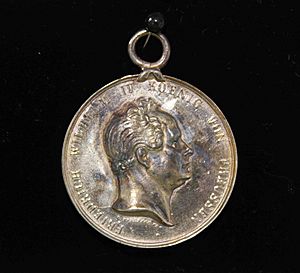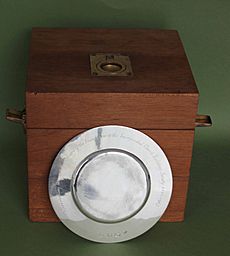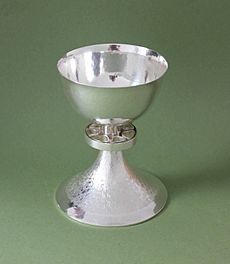National Churches Trust facts for kids
The National Churches Trust is a special charity in the UK. It helps to protect and support church buildings. These buildings are important because of their history, beautiful design, and how they help local communities.
The Trust gives money to fix and update churches. This helps keep them open for everyone to use. They also work with other groups and offer advice. They want more people to know why churches need help. Before this, it was called the Historic Churches Preservation Trust.
Contents
How the Trust Started
By the mid-1900s, many church buildings in Britain were in bad shape. This happened because of changes in how people lived and worked. Also, churches were not looked after during the Second World War. In 1950, people started talking about this problem. A newspaper called The Times even wrote about it.
Around this time, another charity, the Pilgrim Trust, stopped giving money for church repairs. So, the Church of England Assembly decided to create a group to figure out what to do. This led to the start of the Historic Churches Preservation Trust in 1953.
Early Efforts and Funding
The first leader of the Trust was Ivor Bulmer-Thomas. He was a politician. Later, Hugh Llewellyn Jones took over his role. The Trust set up groups of architects to make sure the money was used well.
When it started, the Trust needed about £4 million to reach its goals. They raised money in many ways. These included appeals on radio and TV, special events, and donations from people and companies. Other charities also helped, like the Pilgrim Trust and the Esmée Fairbairn Foundation.
Helping Churches Stay Open
From the beginning, the Trust gave money to fix churches. This included churches that were still in use and those that were no longer used. In 1960, a group suggested a new fund to save important historic churches. This led to the creation of the Redundant Churches Fund in 1968. This fund, now called the Churches Conservation Trust, helps to look after churches that are no longer used for worship.
It took until 1984 to raise the first £4 million. After that, bigger donations started coming in. By the end of 2005, over £27 million had been raised. In 2000 alone, they received more than £2.2 million.
Who Gets Help?
The money given to churches has varied a lot. The smallest grant was £33 in 1957. The largest grants were £100,000 each to a church in Portsea, Portsmouth in 2000 and to Selby Abbey in 2005.
To get a grant, a church had to be:
- Over 100 years old.
- A recognized Christian place of worship.
- Open for public worship.
- Needing important repairs.
At first, only churches in England could get help. In 1987, this was extended to churches and chapels in Wales. The Trust's Grants Committee decides who gets the money. Some churches that received help are now closed. These are cared for by the Churches Conservation Trust.
In 1983, the Historic Churches Preservation Trust also started managing the Incorporated Church Building Society. This group was founded in 1818 to help Anglican churches of any age. In 2007, the Historic Churches Preservation Trust became the National Churches Trust.
What the Trust Does Today
The National Churches Trust is a registered charity. Its main goal is to help save, fix, and improve Christian places of worship across the UK. This includes churches, chapels, and meeting houses. They also help with things inside churches, like stained glass, furniture, and organs.
In 2009, the Trust received over £1.8 million and spent over £2.7 million on its charity work. It had eight staff members. A group of Trustees manages the Trust. The Grants Committee decides which churches receive money.
Types of Grants
The Trust gives different types of grants:
- Grants of £10,000 or more are for urgent repairs to the building's structure.
- Grants between £5,000 and £25,000 help install things like toilets and kitchens.
Since 2005, the Trust has given over £9 million to more than 1,000 churches. It supports churches from any Christian group that is part of Churches Together in Britain and Ireland. The Trust helps churches all over the United Kingdom.
The Trust does not own churches. It also does not support churches that are no longer used for worship. The government or church leaders do not fund the Trust. Its money comes from donations from people, parishes, and other charities.
The Trust works with many Local Churches Trusts across the country. People can also become a "Friend of the National Churches Trust" to support their work.
Special Projects
In July 2017, the Trust started an online competition called Sacred Wales – Cymru Sanctaidd. This competition aimed to find the favorite church or chapel in Wales. It helped to celebrate and raise awareness of Wales' religious history.
Who Leads the Trust
The National Churches Trust has important people who help lead it:
- Patron: King Charles III
- Vice Patron: Prince Richard, Duke of Gloucester
- Presidents: Vacant, Archbishop of Canterbury and Stephen Cottrell, Archbishop of York
Trustees and Officers
- Chief Executive: Claire Walker
- Chairman, Board of Trustees: Sir Philip Rutnam
- Chairman, Grants Committee: Nigel Walter
King of Prussia Gold Medal
The King of Prussia Gold Medal is given by the National Churches Trust. It celebrates new and excellent repair work on church buildings. King Friedrich Wilhelm IV of Prussia gave this medal to the Incorporated Church Building Society in 1857.
The award has been given every year since the early 1980s. This was when the medal was found again during an office move. The winner gets to keep the original medal for one year. After that, they receive a silver copy. The National Churches Trust now manages the work of the Incorporated Church Building Society.
Presidents' Award
The Presidents' Award for church architecture started in 1999. It is given by the leaders of the Ecclesiastical Architects and Surveyors Association and the National Churches Trust. The award includes a chalice (a special cup) and a paten (a small plate).
These items were first made after World War II. They were meant to be loaned to new churches or churches badly damaged by the war. Now, they are lent to the winning church parish for one year.
Images for kids
-
Selby Abbey in North Yorkshire, one of the churches benefitting from the charity






